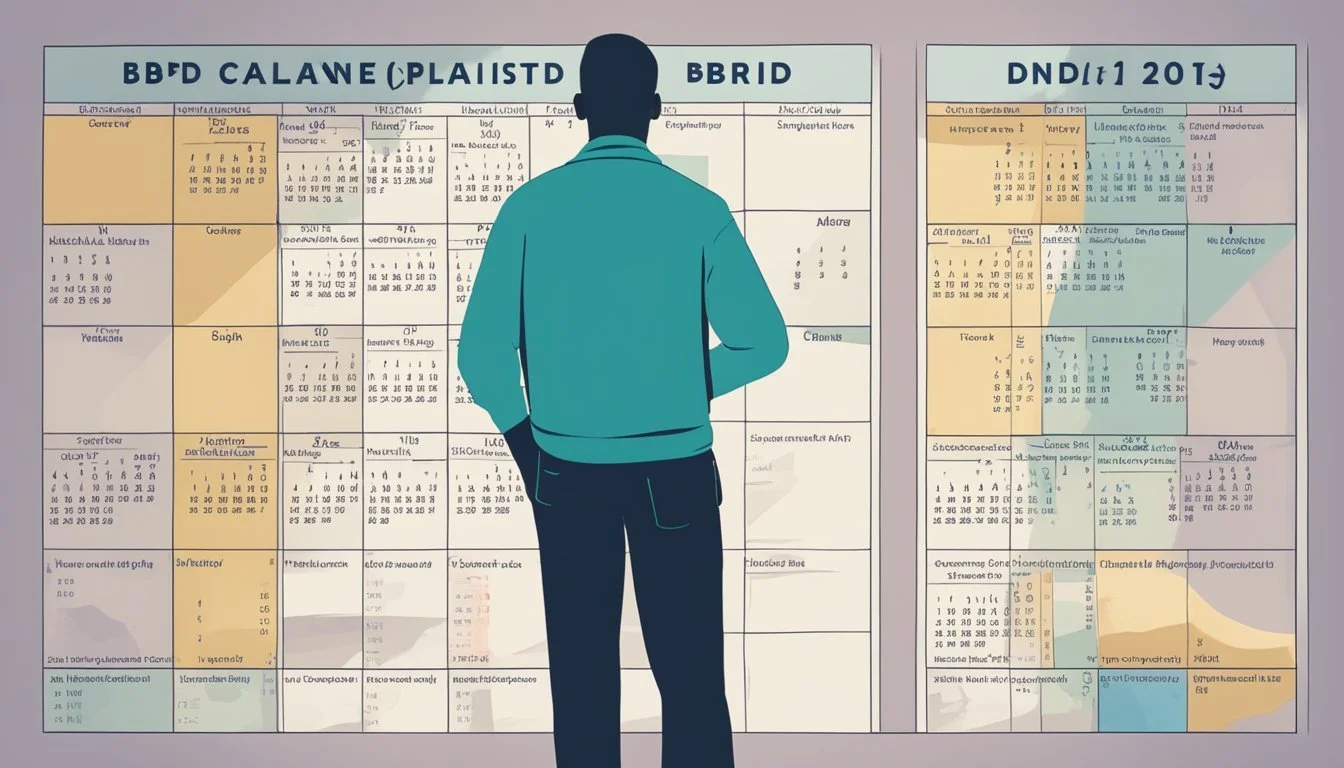10 Myths About BPD That Need to Be Dispelled
Separating Fact from Fiction in Borderline Personality Disorder
Borderline Personality Disorder (BPD) is a complex mental health condition that affects millions of people worldwide. Despite its prevalence, BPD remains widely misunderstood and stigmatized due to persistent myths and misconceptions. These inaccurate beliefs can lead to harmful stereotypes and inadequate support for those living with the disorder.
Dispelling common myths about BPD is crucial for promoting better understanding and compassion towards individuals with this condition. By addressing these misconceptions, we can foster a more informed and supportive environment for those affected by BPD. This article aims to shed light on ten prevalent myths surrounding Borderline Personality Disorder and provide accurate information to counter these false beliefs.
1) BPD is Just Mood Swings
Borderline Personality Disorder (BPD) is often misunderstood as simply experiencing intense mood swings. This common misconception oversimplifies a complex mental health condition.
While mood swings are a symptom of BPD, the disorder encompasses much more. People with BPD struggle with unstable self-image, fear of abandonment, and difficulties in interpersonal relationships.
BPD mood shifts typically occur in response to external triggers, particularly those related to perceived rejection or abandonment. These emotional reactions can be intense and rapid, lasting hours or days.
Unlike typical mood swings, BPD-related emotional changes are often accompanied by impulsive behaviors, self-harm, or suicidal thoughts. These symptoms significantly impact daily functioning and relationships.
BPD also involves persistent feelings of emptiness, identity disturbances, and dissociative symptoms. These aspects distinguish it from mere mood fluctuations and highlight the complexity of the disorder.
Recognizing BPD as more than just mood swings is crucial for proper diagnosis, treatment, and support for individuals living with this challenging condition.
2) Only Women Have BPD
A common misconception about Borderline Personality Disorder (BPD) is that it exclusively affects women. This myth is far from the truth and can be harmful to those struggling with the condition.
While it's true that BPD is diagnosed more frequently in women, men can and do develop this disorder. Research shows that approximately 75% of individuals diagnosed with BPD are women, but the remaining 25% are men.
The gender disparity in diagnosis may be due to several factors. These include differences in how symptoms present between genders and potential biases in the mental health field.
Men with BPD may be misdiagnosed with other conditions like depression, substance abuse disorders, or antisocial personality disorder. This can lead to underreporting of BPD in male populations.
It's crucial to recognize that mental health conditions do not discriminate based on gender. Anyone, regardless of their gender identity, can develop BPD if they meet the diagnostic criteria.
Dispelling this myth is important for ensuring that all individuals with BPD, regardless of gender, receive appropriate diagnosis and treatment. It also helps reduce stigma and promotes better understanding of the disorder.
3) People with BPD are Manipulative
This common misconception stems from a misunderstanding of BPD symptoms. People with BPD often experience intense emotions and fear of abandonment, which can lead to behaviors others may perceive as manipulative.
In reality, these actions are usually not intentional attempts to manipulate, but rather desperate efforts to manage overwhelming feelings and maintain relationships. Individuals with BPD typically struggle with emotional regulation and may engage in impulsive behaviors as a coping mechanism.
It's important to recognize that manipulative behavior is not a defining characteristic of BPD. Many people with this disorder are actively working to improve their interpersonal skills and develop healthier coping strategies.
Labeling all individuals with BPD as manipulative perpetuates harmful stereotypes and stigma. This can discourage people from seeking help and hinder their recovery process.
Mental health professionals emphasize that effective treatment for BPD focuses on developing emotional regulation skills, improving interpersonal relationships, and building self-awareness. With proper support and therapy, individuals with BPD can learn to manage their symptoms and lead fulfilling lives.
4) BPD is the Same as Bipolar Disorder
Borderline Personality Disorder (BPD) and Bipolar Disorder are distinct mental health conditions that are often confused due to some overlapping symptoms. While both can involve mood swings and impulsivity, they are fundamentally different disorders.
BPD is a personality disorder characterized by unstable relationships, self-image, and emotions. Mood shifts in BPD tend to be rapid, lasting hours or days, and are often triggered by interpersonal events.
Bipolar Disorder, on the other hand, is a mood disorder featuring alternating episodes of mania and depression. These episodes typically last weeks or months, and are not necessarily linked to external triggers.
The treatment approaches for these disorders also differ. BPD often responds well to specific psychotherapies, such as Dialectical Behavior Therapy. Bipolar Disorder primarily relies on mood stabilizing medications and psychoeducation.
Accurate diagnosis is crucial for effective treatment. While it's possible for an individual to have both conditions, they are separate disorders with distinct causes and manifestations.
5) Therapy Doesn't Work for BPD
This myth stems from outdated beliefs about borderline personality disorder (BPD). In reality, several effective therapeutic approaches exist for treating BPD.
Dialectical behavior therapy (DBT) has shown significant success in helping individuals with BPD manage their symptoms. This approach combines cognitive-behavioral techniques with mindfulness practices.
Mentalization-based therapy (MBT) is another evidence-based treatment for BPD. It focuses on improving a person's ability to understand their own and others' mental states.
Transference-focused psychotherapy (TFP) has also demonstrated positive outcomes for BPD patients. This psychodynamic approach addresses underlying personality structure and interpersonal difficulties.
Schema therapy, which integrates elements from various therapeutic modalities, has proven effective in treating BPD as well. It helps individuals identify and modify maladaptive patterns of thought and behavior.
With appropriate treatment, many individuals with BPD experience substantial improvement in their symptoms and quality of life. While therapy for BPD may be challenging, it can lead to meaningful progress and recovery.
6) Medication is the Only Solution
Contrary to popular belief, medication is not the sole treatment for Borderline Personality Disorder (BPD). While medications can help manage certain symptoms, they are not considered a primary treatment for BPD itself.
Psychotherapy, particularly evidence-based approaches like Dialectical Behavior Therapy (DBT) and Mentalization-Based Therapy (MBT), form the cornerstone of BPD treatment. These therapies focus on developing coping skills, emotional regulation, and improving interpersonal relationships.
Medication may be prescribed to address specific symptoms or co-occurring conditions. For example, antidepressants might be used to manage depression or anxiety associated with BPD.
A comprehensive treatment plan often combines therapy, potential medication, and lifestyle changes. This multi-faceted approach aims to address the complex nature of BPD and improve overall quality of life.
It's important to note that medication decisions should be made in consultation with a mental health professional. Each individual's treatment needs may vary, and what works for one person may not be suitable for another.
7) BPD Cannot Be Diagnosed Until Adulthood
Contrary to popular belief, Borderline Personality Disorder (BPD) can be diagnosed before adulthood. While the Diagnostic and Statistical Manual of Mental Disorders (DSM-5) allows for diagnosis in adolescence, many clinicians are hesitant to do so.
The symptoms of BPD often first appear during teenage years. Some mental health professionals argue that personality is still developing during adolescence, making diagnosis challenging.
However, early diagnosis can lead to earlier intervention and treatment. This can potentially improve outcomes for individuals with BPD. Research suggests that BPD traits in adolescents are as stable as those in adults.
It's important to note that a BPD diagnosis requires symptoms to be present for at least a year. These symptoms should also not be better explained by other conditions or typical adolescent development.
Mental health professionals can diagnose BPD in adolescents when appropriate. Early recognition and treatment can provide crucial support during formative years.
8) People with BPD are Violent
The myth that individuals with Borderline Personality Disorder (BPD) are inherently violent is both inaccurate and harmful. Research does not support the notion that BPD leads to increased violent behavior towards others.
People with BPD may experience intense emotions and struggle with impulse control, but this does not equate to violence. In fact, those with BPD are more likely to harm themselves than others.
The misconception of violence may stem from a misunderstanding of BPD symptoms. Emotional outbursts or self-destructive behaviors are often mistaken for aggression towards others.
It's important to recognize that BPD affects individuals differently. Many people with BPD lead peaceful lives and maintain healthy relationships without any violent incidents.
Treatment and therapy can help individuals with BPD manage their emotions and improve interpersonal skills. With proper support, those with BPD can learn effective coping strategies and lead fulfilling lives.
Dispelling this myth is crucial for reducing stigma and promoting understanding of BPD. It encourages a more compassionate approach to those living with this condition.
9) BPD Means a Lifelong Battle
The idea that Borderline Personality Disorder (BPD) is an unending, lifelong struggle is a misconception. While BPD can present significant challenges, many individuals experience substantial improvement with proper treatment and support.
Research shows that BPD symptoms often decrease in intensity over time. Many people with BPD see a reduction in symptoms as they age, even without intervention. This natural course of the disorder offers hope for long-term improvement.
Effective treatments like Dialectical Behavior Therapy (DBT) and other evidence-based approaches have shown promising results. These therapies help individuals develop coping skills, regulate emotions, and improve interpersonal relationships.
Studies indicate that a significant percentage of people with BPD no longer meet the diagnostic criteria after several years of treatment. This suggests that recovery is possible and that the disorder may not be a permanent condition for everyone.
While managing BPD can be an ongoing process, it's important to recognize that progress and positive change are achievable. Many individuals with BPD lead fulfilling lives, maintain healthy relationships, and pursue successful careers.
10) BPD is Rare
Contrary to popular belief, Borderline Personality Disorder (BPD) is not as rare as many people think. Studies suggest that BPD affects approximately 1.6% to 5.9% of the general population.
This prevalence rate is comparable to or even higher than some other well-known mental health conditions. For instance, it is more common than schizophrenia and bipolar disorder.
In clinical settings, BPD is even more prevalent. It is estimated that about 10% of psychiatric outpatients and 20% of psychiatric inpatients meet the criteria for BPD.
The misconception about BPD's rarity may stem from underdiagnosis or misdiagnosis. Some healthcare professionals may not be adequately trained to recognize BPD symptoms, leading to missed diagnoses.
Additionally, the stigma surrounding personality disorders can discourage individuals from seeking help, further contributing to the perception that BPD is uncommon. Raising awareness about BPD's true prevalence is crucial for improving diagnosis rates and access to appropriate treatment.
Understanding Borderline Personality Disorder
Borderline Personality Disorder (BPD) is a complex mental health condition characterized by intense emotions, unstable relationships, and impulsive behaviors. It affects how a person thinks, feels, and interacts with others.
What Is BPD?
BPD is a psychiatric disorder that impacts an individual's self-image, emotions, and relationships. People with BPD often experience intense fear of abandonment and struggle with maintaining stable interpersonal connections.
The disorder typically begins in early adulthood and can persist for years. BPD affects approximately 1.6% of the general population, with higher rates among women.
Individuals with BPD may experience rapid mood swings, intense anger, and chronic feelings of emptiness. These symptoms can significantly impact their daily functioning and quality of life.
Common Symptoms and Behaviors
BPD manifests through various symptoms and behaviors:
Intense and unstable relationships
Fear of abandonment
Impulsive and risky behaviors
Chronic feelings of emptiness
Rapid mood swings
Intense anger or difficulty controlling anger
Stress-related paranoid thoughts
Self-harm or suicidal behaviors
Unstable self-image or sense of self
These symptoms can vary in intensity and frequency among individuals with BPD. Some may experience all symptoms, while others may only exhibit a few.
Diagnostic Criteria
Mental health professionals use specific criteria to diagnose BPD. The Diagnostic and Statistical Manual of Mental Disorders (DSM-5) outlines nine criteria for BPD:
Frantic efforts to avoid real or imagined abandonment
Unstable and intense interpersonal relationships
Identity disturbance or unstable self-image
Impulsivity in at least two potentially self-damaging areas
Recurrent suicidal behavior, gestures, or threats, or self-mutilating behavior
Affective instability due to marked reactivity of mood
Chronic feelings of emptiness
Inappropriate, intense anger or difficulty controlling anger
Transient, stress-related paranoid ideation or severe dissociative symptoms
To receive a BPD diagnosis, an individual must meet at least five of these criteria. It's important to note that a comprehensive evaluation by a qualified mental health professional is necessary for an accurate diagnosis.
Impact of Myths on BPD
Myths surrounding Borderline Personality Disorder (BPD) can have far-reaching consequences for those affected by the condition. These misconceptions shape public perception, influence personal relationships, and create obstacles to proper care and treatment.
Stigma and Misconceptions
Widespread myths about BPD contribute to significant stigma. Many people incorrectly believe individuals with BPD are manipulative or dangerous. This can lead to social isolation and discrimination.
Employers may hesitate to hire someone with a BPD diagnosis due to unfounded fears about workplace behavior. Healthcare professionals sometimes avoid treating BPD patients based on stereotypes about them being "difficult" or "untreatable."
These misconceptions can cause intense shame and self-doubt in those with BPD. They may internalize negative stereotypes, worsening their symptoms and self-esteem.
Challenges in Relationships
Myths about BPD often strain personal relationships. Partners, friends, and family members may misinterpret BPD symptoms as intentional manipulation or attention-seeking behavior.
This misunderstanding can lead to:
Reduced empathy and support
Increased conflict and tension
Difficulty maintaining long-term relationships
People with BPD may struggle to form deep connections due to others' preconceived notions. They might hide their diagnosis out of fear of rejection, preventing honest communication and trust-building.
Barriers to Treatment
Misconceptions about BPD create significant obstacles to effective treatment. Some myths suggest that BPD is untreatable, discouraging individuals from seeking help.
Many therapists lack proper training in BPD treatment due to persistent stigma. This shortage of knowledgeable providers limits access to specialized care like Dialectical Behavior Therapy (DBT).
Insurance companies may restrict coverage for BPD treatment based on outdated beliefs about its prognosis. This financial barrier prevents many from receiving the long-term care needed for recovery.
Myths can also impact treatment adherence. Patients may become discouraged if they don't see immediate results, unaware that BPD recovery often requires sustained effort and patience.
Debunking Myths with Facts
Dispelling misconceptions about Borderline Personality Disorder (BPD) requires examining clinical evidence, personal experiences, and media portrayals. Accurate information from these sources helps challenge common myths and promote a more nuanced understanding of BPD.
Clinical Perspectives
Research shows BPD affects approximately 1.6% of adults in the United States. This contradicts the myth that BPD is rare. Studies indicate that BPD is as common as bipolar disorder and schizophrenia.
Contrary to popular belief, BPD is treatable. Evidence-based therapies like Dialectical Behavior Therapy (DBT) and Mentalization-Based Treatment (MBT) have shown effectiveness in managing BPD symptoms.
The notion that BPD only affects women is false. While women are diagnosed more frequently, men also experience BPD. Gender bias in diagnosis may contribute to this imbalance.
Personal Narratives
Individuals with BPD often report feeling misunderstood and stigmatized. Many emphasize that their actions are not manipulative, but stem from intense emotions and fear of abandonment.
People with BPD can maintain stable relationships and careers. With proper treatment and support, many lead fulfilling lives and manage their symptoms effectively.
Recovery is possible. Numerous personal accounts describe significant improvements in emotional regulation and interpersonal relationships through therapy and self-work.
Role of Media
Media portrayals of BPD often perpetuate harmful stereotypes. Characters with BPD are frequently depicted as violent or unstable, reinforcing stigma.
Accurate representations in film and television can help educate the public. Some recent productions have made efforts to portray BPD more realistically, showing both struggles and strengths.
Social media platforms have become spaces for BPD awareness. Many individuals use these platforms to share experiences, dispel myths, and provide support to others affected by BPD.







